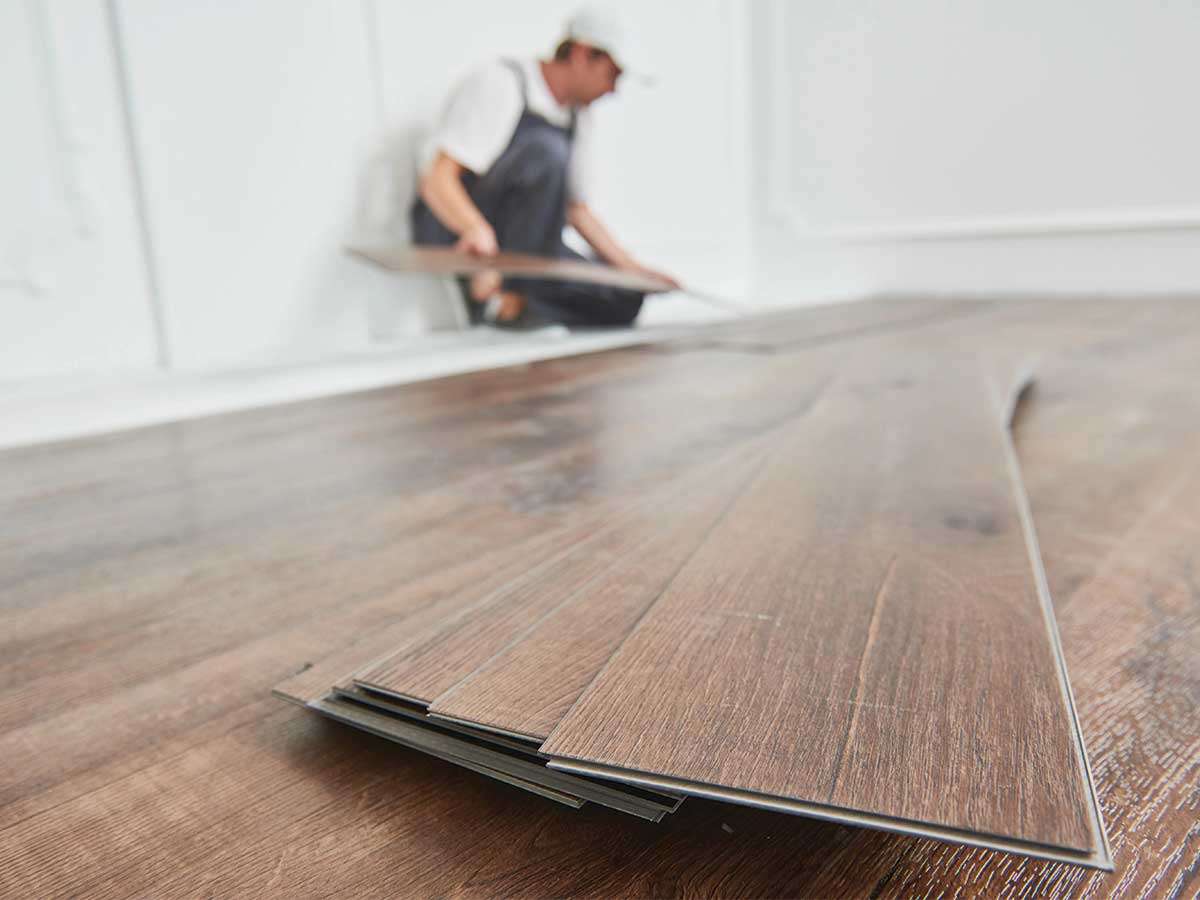Does Vinyl Flooring Expand and Contract

Vinyl flooring can expand and contract because of temperature and humidity changes. It is made mostly of polyvinyl chloride (PVC), which responds to the environment. Stabilizers and plasticizers are added to the flooring to handle these changes. However, temperature changes can still cause it to swell or shrink.
To prevent problems, it is important to use proper installation techniques. This includes letting the flooring adjust to the room (acclimation period) and leaving gaps around the edges for expansion. Keeping a stable indoor climate and good-quality adhesive can also help keep the flooring stable.
Knowing these basics helps you manage vinyl flooring and avoid problems over time.
Vinyl Flooring Composition
Vinyl flooring, primarily composed of polyvinyl chloride (PVC), is engineered with several additives and layers to enhance its durability, flexibility, and aesthetic appeal.
Composition:
- Polyvinyl Chloride (PVC): The primary component of vinyl flooring provides strength and resilience.
- Stabilizers: These additives stabilize the material against temperature fluctuations, preventing it from breaking down over time due to heat or cold exposure.
- Plasticizers: Added to make vinyl flexible, plasticizers enable the material to mimic the look and feel of natural materials like wood or stone.
- Fillers (e.g., limestone): Fillers add strength and density to the vinyl, ensuring it achieves the desired thickness and hardness. Limestone also contributes to the material’s resilience and structural integrity.
- Top Layer (high-density urethane): The topmost layer of vinyl flooring is typically made from high-density urethane. This layer protects against scratches, stains, and sunlight, enhancing the floor’s durability and longevity.
Vinyl flooring’s construction with PVC, stabilizers, plasticizers, fillers like limestone, and a protective urethane top layer underscores its durability, flexibility, and aesthetic versatility. These elements work in tandem to create a flooring solution that not only mimics the natural look of wood or stone but also withstands the rigors of daily use while maintaining its structural integrity. Proper installation, including leaving an expansion gap, ensures that vinyl flooring performs optimally and retains its appearance for years to come.
Expansion and Contraction Basics
Vinyl flooring, despite its durability and versatility, is sensitive to temperature changes, particularly variations in heat and humidity. To ensure its stability and long-term performance, proper acclimation before installation is crucial.
Understanding Temperature Effects:
- Expansion and Contraction: Vinyl flooring expands when exposed to warmer temperatures and contracts when it cools down. This natural reaction to temperature changes can lead to issues like buckling, gaps between planks, or even adhesive failure if not properly managed.
Importance of Acclimation:
- Purpose: Acclimation allows vinyl planks or tiles to adjust to the temperature and humidity conditions of the room where they will be installed. This process minimizes the risk of expansion or contraction after installation, promoting a stable and durable flooring surface.
- Duration: Typically, manufacturers recommend leaving vinyl flooring materials in the installation room for 24 to 48 hours before installation begins. During this period, the flooring adapts to the ambient conditions, reducing the likelihood of dimensional changes post-installation.
Best Practices for Acclimation:
- Storage: Store the vinyl flooring in the room where it will be installed, ensuring it remains in a horizontal position and away from direct sunlight or extreme temperatures.
- Open Packaging: If the flooring is packaged in boxes or wrapped, open the packaging to allow air circulation around the planks or tiles.
- Room Conditions: Maintain normal room temperature and humidity levels during acclimation to replicate the environment the flooring will be exposed to after installation.
By allowing vinyl flooring to acclimate properly before installation, you enhance its stability and minimize the risk of problems associated with temperature-induced expansion or contraction. This proactive approach ensures your vinyl flooring remains aesthetically pleasing and functional for years to come in various environmental conditions.
Environmental Influences
To grasp how vinyl flooring responds to its environment, it’s essential to consider several key factors that influence its expansion and contraction:
- Temperature: Vinyl flooring, being thermoplastic, expands when exposed to heat and contracts in colder temperatures. This thermal reaction necessitates correct installation practices to accommodate these natural changes without causing damage. It’s vital to leave expansion gaps around the perimeter and at transitions to allow for thermal expansion and contraction.
- Sunlight Exposure: Direct sunlight can significantly impact vinyl flooring by heating it unevenly, causing localized expansion in exposed areas. Over time, UV radiation from sunlight can also degrade the vinyl material and weaken adhesives, exacerbating the issues of expansion and contraction. To mitigate these effects, using window treatments to reduce direct sunlight exposure and opting for UV-resistant flooring materials can help maintain the floor’s stability and longevity.
- Moisture Levels: Vinyl flooring is susceptible to moisture variations. High humidity can cause the material to absorb moisture and swell, potentially leading to damage. Conversely, low humidity can cause the vinyl to shrink. Proper preparation of the subfloor is critical, ensuring it is dry, clean, and level before installation. Additionally, the use of moisture barriers can effectively prevent moisture from affecting the flooring, especially in areas prone to humidity or potential moisture exposure.
- Adhesive Quality: The type and quality of adhesive used during installation play a pivotal role in how well vinyl flooring maintains its stability over time. High-quality adhesives are engineered to maintain strong bonds under different environmental conditions. They help ensure that the flooring remains securely attached, minimizing the risk of movement or detachment that could compromise its longevity and performance.
Temperature and Humidity Impact
Understanding how temperature and humidity impact vinyl flooring is crucial for maintaining its integrity and preventing issues like gaps, buckling, or damage over time. Here’s a detailed look at how these factors affect vinyl flooring:
1. Temperature Effects:
- Expansion and Contraction: Vinyl flooring, being sensitive to temperature changes, expands when exposed to heat and contracts when it cools down. In warmer temperatures, vinyl planks can expand excessively, potentially causing them to push against walls or other fixed structures, leading to buckling or gaps between planks. Conversely, in cold temperatures, vinyl may shrink, leaving gaps between planks or edges.
- Prevention: To mitigate these issues, it’s crucial to allow the vinyl flooring to acclimate to the room’s temperature before installation. This helps minimize sudden changes that could lead to expansion or contraction. Additionally, leaving expansion gaps around the perimeter and using transition strips between rooms can accommodate these natural movements without causing damage.
2. Humidity Impact:
- Moisture Absorption: High humidity levels can cause vinyl planks to absorb moisture from the air, leading to swelling and potential warping of the flooring. This can result in uneven surfaces or damage over time if not addressed.
Drying Out: Conversely, low humidity levels can cause vinyl to dry out and shrink, which may also lead to gaps between planks or tiles. - Prevention: Maintaining stable indoor humidity levels is crucial for preserving vinyl flooring. Using a dehumidifier in humid climates or during humid seasons can help regulate moisture levels. Proper subfloor preparation, including the use of a moisture barrier, helps prevent moisture from seeping up through the subfloor and affecting the vinyl.
3. Moisture Barrier Installation:
- Purpose: Installing a moisture barrier under the vinyl flooring serves as a preventive measure against moisture infiltration from the subfloor. This barrier helps maintain the stability of the vinyl by minimizing the risk of expansion or contraction due to moisture absorption.
- Materials: Moisture barriers can be made from various materials such as polyethylene sheets or specialized underlayment products designed to resist moisture. They are installed directly over the subfloor before laying the vinyl planks or tiles.
By understanding and proactively managing how temperature and humidity affect vinyl flooring, homeowners can ensure their flooring remains durable, attractive, and functional for years to come. Proper installation practices and ongoing maintenance play key roles in preserving the integrity of vinyl flooring in diverse environmental conditions.
Installation Tips
Installing vinyl flooring correctly is crucial for ensuring its durability and performance over time. Here are key tips to follow for a successful installation:
Expansion Gap:
Leave a small expansion gap around the perimeter of the room and at transitions between rooms or flooring sections. This gap allows the vinyl tiles or planks to expand and contract naturally with changes in temperature and humidity, preventing issues like buckling or gaps.
Subfloor Preparation:
Ensure the subfloor is clean, dry, smooth, and level before installing vinyl flooring. Remove any debris, dust, or bumps that could affect the adhesive bond or the stability of the flooring.
Quality Adhesive:
Use a high-quality adhesive specifically designed for vinyl flooring. This ensures a strong bond between the vinyl tiles or planks and the subfloor, preventing them from shifting or coming loose over time.
Suitable Locations:
Install vinyl flooring in appropriate locations. Avoid placing vinyl in areas prone to excessive moisture, such as bathrooms or basements, unless the product is explicitly designed for these environments. For rooms with significant temperature variations, like sunrooms, choose vinyl tiles or planks that are engineered to withstand such conditions.
Follow Manufacturer Instructions:
Always follow the installation instructions provided by the manufacturer. These guidelines are tailored to the specific product you are using and include important details such as acclimation requirements, recommended adhesives, and installation techniques. Following these instructions ensures optimal performance and longevity of your vinyl flooring.
Importance of Expansion Gaps
Ensuring the correct installation of vinyl flooring involves maintaining proper expansion gaps around the room’s edges. Here are the key points to understand and implement:
Importance of Expansion Gaps:
- Purpose: Expansion gaps, typically between 1/4 to 1/2 inch, allow vinyl flooring to expand and contract in response to changes in temperature and humidity. Without these gaps, the flooring could buckle, warp, or develop other stress-related issues.
Maintaining Clear Gaps:
- Prevention of Blockage: It’s crucial to ensure that baseboards, trim, and heavy furniture do not block these gaps. Obstructed gaps can create stress points, leading to potential damage or buckling of the flooring.
- Use of Spacers: During installation, using spacers helps maintain uniform expansion gaps around the room. This ensures that the gaps are consistent and effective.
Compatibility with Other Flooring and Room Elements:
- Seamless Integration: Proper expansion gaps facilitate the seamless integration of vinyl flooring with other types of flooring or room elements, ensuring a professional and cohesive look.
- Ease of Maintenance: These gaps also make future maintenance and potential repairs easier, as the flooring has the necessary room to expand and contract without causing issues.
Installation Tips:
- Pre-installation Acclimation: Allow the vinyl flooring to acclimate to the room’s environment for at least 24 to 48 hours before installation to reduce the risk of excessive expansion or contraction post-installation.
- Subfloor Preparation: Ensure the subfloor is clean, dry, and level. A well-prepared subfloor provides a stable foundation, reducing the risk of uneven expansion or contraction.
- Manufacturer Guidelines: Always follow the specific guidelines provided by the flooring manufacturer. These instructions are tailored to the product and are critical for ensuring proper installation and performance.
Long-term Benefits:
- Longevity: Properly installed expansion gaps enhance the lifespan of vinyl flooring by preventing structural damage.
- Performance: Ensuring these gaps are maintained preserves the flooring’s aesthetic and functional integrity over time.
By paying close attention to the proper placement and maintenance of expansion gaps, you can ensure that your vinyl flooring remains durable, attractive, and functional for years. This crucial step in the installation process safeguards against common issues and supports the overall performance and longevity of the flooring.
Subfloor and Underlayment Roles
The subfloor and underlayment play crucial roles in ensuring the longevity and performance of vinyl flooring. Here’s a detailed look at their functions and importance:
The Subfloor:
- Support Base: The subfloor is the foundational layer that supports the entire flooring system. It needs to be flat, dry, and free of any defects to prevent uneven wear and damage to the vinyl flooring.
- Load Distribution: The subfloor absorbs and evenly distributes the weight across the floor, reducing stress on the vinyl. This prevents concentrated pressure points that can lead to damage over time.
- Preparation: Proper preparation of the subfloor is critical. Any imperfections, such as bumps, dips, or moisture issues, must be addressed to provide a stable and suitable base for the flooring.
The Underlayment:
- Comfort and Noise Reduction: The underlayment is installed between the subfloor and the vinyl flooring. It adds a layer of cushioning, making the floor more comfortable to walk on. It also reduces noise, providing a quieter environment.
- Moisture Barrier: A high-quality underlayment acts as a moisture barrier, protecting the vinyl flooring from potential moisture issues that can cause swelling, warping, or mold growth.
- Temperature Management: The underlayment helps manage temperature changes, reducing the risk of expansion and contraction of the vinyl flooring. This stabilizes the floor and prevents gaps or buckling.
- Imperfection Smoothing: It smooths out minor imperfections in the subfloor, creating a more even surface for the vinyl flooring. This ensures better adhesion and a more uniform appearance.
Key Considerations for Subfloor and Underlayment:
- Material Selection: Choose appropriate materials for both the subfloor and underlayment based on the specific requirements of your vinyl flooring and the environment where it will be installed.
- Installation Quality: Both layers need to be installed with care and precision. Poor installation can lead to problems such as uneven surfaces, increased noise, or moisture penetration.
- Manufacturer Recommendations: Always follow the guidelines and recommendations provided by the flooring and underlayment manufacturers. These instructions are tailored to ensure optimal performance and compatibility of the flooring system.
Maintenance Tips
Vinyl flooring is known for its durability and ease of maintenance. However, following some straightforward care tips can help ensure it stays in excellent condition for many years. Here’s how to properly care for your vinyl flooring:
Despite these considerations, vinyl flooring presents several benefits for kitchen use:
Regular Cleaning
- Damp Mop and Mild Cleaner: Clean your vinyl flooring regularly using a damp mop and a mild cleaner. Avoid using harsh chemicals or abrasive tools, as these can scratch or damage the surface.
- High-Traffic Areas: Pay extra attention to areas with high foot traffic. These areas can wear out faster, so frequent cleaning can help maintain their appearance.
Temperature and Sunlight Control
- Steady Indoor Temperature: Keep your indoor temperature steady to minimize the expansion and contraction of the vinyl flooring. Significant temperature changes can cause the floor to warp or develop gaps.
- Avoid Direct Sunlight: Protect the floor from prolonged exposure to direct sunlight. UV rays can cause the vinyl to expand and contract excessively, leading to potential warping or gaps. Use curtains or blinds to limit direct sunlight exposure.


















